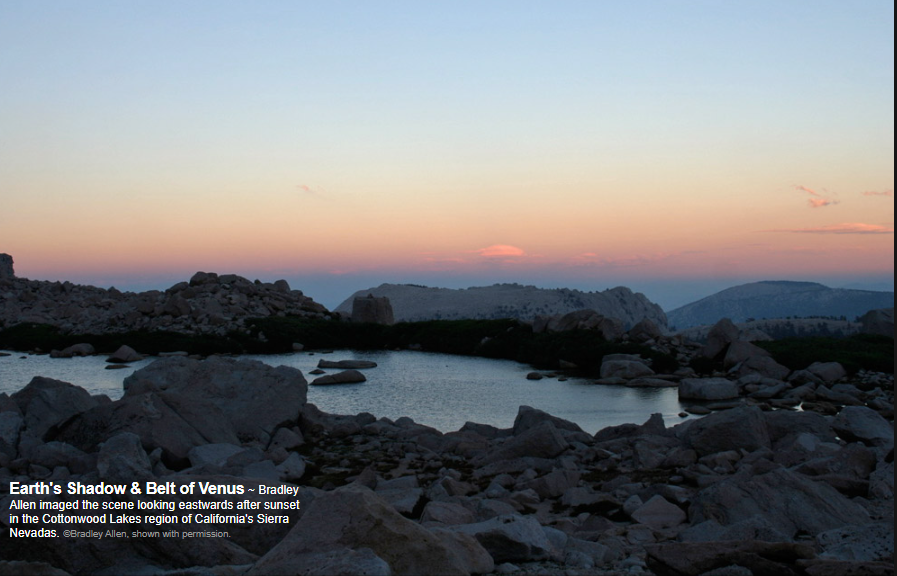OPOD - Belt of Venus
The Belt of Venus: A Stunning Atmospheric Phenomenon
Have you ever looked up at the sky after sunset or before dawn and noticed a beautiful purple-gray band rising from the horizon? This captivating phenomenon is known as the Belt of Venus. In this article, we will delve deeper into the science behind this atmospheric spectacle and discover how it gets its name.
Earth's Shadow and the Anti-Twilight Arch
For those in the Northern Hemisphere, winter is an excellent time to witness the Earth's shadow shortly before dawn in the west and after sunset in the east. As the sun sets, a dark shadow cast by our planet becomes visible, extending into the atmosphere. This shadow gradually becomes less distinct as it rises until it merges with the twilight sky.
At the top of this shadow, a breathtaking rosy pink glow emerges, creating what is referred to as the 'anti-twilight arch' or the Belt of Venus. This ethereal glow is caused by sunlight being scattered by particles in the atmosphere, resulting in highly reddened rays that give the arch its distinct color.
A Spectacular Display
To witness this awe-inspiring phenomenon, simply look eastwards after sunset or westwards before dawn. As darkness sets in, observe how the Earth's shadow becomes more pronounced and distinct as it sinks towards the horizon. Meanwhile, the Belt of Venus adorns the dark shadow with its striking pink hue, creating a mesmerizing contrast against the twilight sky.
The Origins of the Name
Curious about how the Belt of Venus acquired its intriguing name? Unfortunately, that story will have to wait for another time. Rest assured, we will explore the origins and history of this fascinating appellation in a future edition of OPOD.
In conclusion, the Belt of Venus is a captivating atmospheric phenomenon that graces our skies during certain times of the day. Its rosy pink glow atop Earth's shadow creates a stunning visual display that is best observed after sunset in the east or before dawn in the west. Stay tuned for more information on the origins of its name and delve deeper into the science behind this celestial spectacle. Keep your eyes to the skies and be prepared to be amazed by the wonders of our atmosphere.

Earth's Shadow & Belt of Venus ~ Bradley Allen imaged the scene looking eastwards after sunset in the Cottonwood Lakes region of California's Sierra Nevadas. ©Bradley Allen, shown with permission.
For the Northern Hemisphere, now and onwards through winter is a good time to see the Earth's shadow shortly before dawn in the west and after sunset in the east.
After sunset look eastwards to see a purple-gray band rising from the horizon. This is the shadow of the solid earth cast through the still sunlit higher atmosphere. As the shadow rises it gets less and less distinct until finally it merges with the twilit sky. The dark shadow is topped by a rosy pink glow - the 'anti-twilight arch sometimes called the 'Belt of Venus'. The glow is highly reddened sun rays backscattered by the atmosphere.
Look westwards before dawn to see the reverse sequence. As the sky lightens the Earth's shadow becomes more and more dark and distinct as it sinks towards the horizon.
How did the Belt of Venus get its name? More about that in a later OPOD.
Note: this article has been automatically converted from the old site and may not appear as intended. You can find the original article here.
Reference Atmospheric Optics
If you use any of the definitions, information, or data presented on Atmospheric Optics, please copy the link or reference below to properly credit us as the reference source. Thank you!
-
<a href="https://atoptics.co.uk/blog/opod-belt-of-venus-2/">OPOD - Belt of Venus</a>
-
"OPOD - Belt of Venus". Atmospheric Optics. Accessed on November 23, 2024. https://atoptics.co.uk/blog/opod-belt-of-venus-2/.
-
"OPOD - Belt of Venus". Atmospheric Optics, https://atoptics.co.uk/blog/opod-belt-of-venus-2/. Accessed 23 November, 2024
-
OPOD - Belt of Venus. Atmospheric Optics. Retrieved from https://atoptics.co.uk/blog/opod-belt-of-venus-2/.